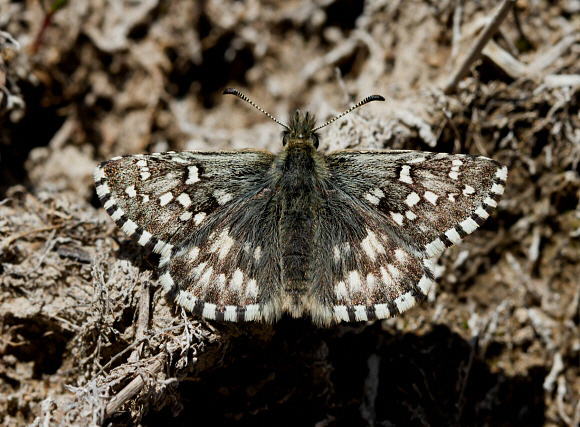
Introduction
The subfamily Pyrginae are characterised by their habit of basking with wings outspread, compared to the half-open position favoured by the Hesperiinae. In North and South America 580 species are placed within the tribe Pyrgini.
There are about 50 known species in the cosmopolitan genus Pyrgus, which has representatives in Europe and temperate Asia, as well as in North central and South America. The genus is instantly recognisable from the pattern of squarish white spots on a grizzled greyish ground colour, and by the conspicuous chequered fringes to the wings. All Pyrgus males have the basal half of the leading edge of the forewing folded back. Within the fold are hundreds of specialised wing scales called androconia, from which pheromones are disseminated to entice females into copulation.
The commonest and most widely distributed species in North America is communis which is found in southern Canada, throughout the USA and Central America, and south along the Andes to Peru.
Pyrgus centaureae is a northern species, found in the Rocky Mountains and throughout Canada. It is also found in Siberia and subarctic regions of Europe and Asia.
Habitats
This species breeds in alpine meadows, tundra and other northern and high altitude habitats.
Lifecycle
The egg is pale green, and is laid singly on the underside of a leaf of the foodplant. The larva feeds on the leaves of Potentilla, Fragaria and Rubus ( Rosaceae ). It is greyish or olive-brown on colour and has a black head. It lives within a flimsy shelter constructed by folding over a leaf and fixing it in place with a few strands of silk. After each moult it moves and builds another shelter. The pupa is whitish, mottled heavily with blackish, and has black rings around the lower abdominal segments.
Adult behaviour
Both sexes bask on low herbage, bare ground or stones, with wings outspread. They have a rapid darting flight, always close to the ground. Males are territorial, using stones or small fallen branches as perches from which they dart up to intercept females or to challenge other males.
The butterflies visit a variety of low growing flowering plants for nectar, feeding with the wings held half open. At dusk they go to roost on dead flowers or on the terminal leaves of herbaceous plants.
